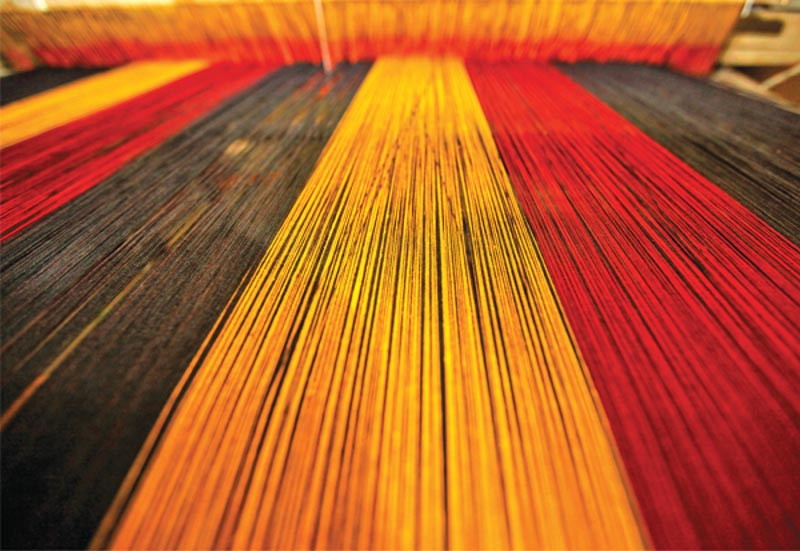
The feet pedal frantically, deft fingers draw the cords that work the loom, the threads are drawn one by one, the loud clacking and trembling of the wooden contraption is hypnotic. It is a complex blend of skill and experience that yield the woven fabric from fine threads complete with a melody of designs and colours.
Words Prasadini Nanayakkara Photographs Damith Wickramasinghe
Almost 50 years ago, the looms hummed quietly in the village of Ihala Madampelle, Gampaha. Back then the industry was young and a worker would produce one or two of the handloom fabrics to sell at a shop nearby. Today the hum of the loom continues picking up the skill naturally from the older generation however with far more zeal in a thriving industry.
As part of its efforts to encourage cottage and small scale industry, the Liya Abhiman Organisation headed by Pushpa Rajapaksa has stepped in to boost the existing community based production of handloom in Ihala Madampelle. Many houses in the region host its own workshop where three to five looms function and are worked by members of family and others in the community. With a training centre setup in the vicinity traditional weavers are now able to hone their skill passed down from their fathers or mothers. Throughout Ihala Madampelle, approximately 60 families are actively engaged in weaving, having received a formal training at the centre. Currently the third cycle of training is nearing completion to add much needed hands to the burgeoning cottage industry in the region. While providing brand new looms to 65 families in the community, the establishment of the training centre has afforded these traditional weavers to prepare marketable products of a finer quality and in turn establish a clientele through Liya Abhiman.
Everywhere were trappings of a lifestyle centred around weaving. Spools of thread and finished products bundled together waiting for collection, piled the corners of the house.
One of 65 members from the first cycle of trainees to emerge from the training centre is Turin Ranaweera who welcomed us to his humble abode. Everywhere were trappings of a lifestyle centred around weaving. Spools of thread and woven products bundled together waiting for collection, piled the corners of the house. A low rumble echoed in the distance – their workshop already in motion early in the day. We followed the sound of the erratic hum to see for ourselves the journey from thread to fabric.
The close confines of a little shack sheltered five looms. Here, Ranaweera and his wife, son and two other members of the community work the five looms daily. While a seasoned weaver sat at the loom coordinating its many functions much like a well oiled machine, the set up of the loom in itself appeared complex. Ranaweera together with his wife and son, obliged our wide-eyed curiosity. The popular choice of threads used to weave fabric is cotton yarn as opposed to polyester used in the past. The first step of rolling the cotton yarn into spindles or bobbins is enabled with a spinning wheel. The traditional wheel is hand powdered and we watched as the soft whirr of the wheel spun bobbins that collected into a pile.
Thereafter the bobbins are mounted on a scaffold like structure and the threads from a pre-determined number of bobbins are drawn to a hefty beam, which is rolled till the individual threads wrap evenly along its length. The hefty beam is then installed into the loom. It is the “reem” a comb like apparatus, however that determines the quality of the cloth. The threads unwound from the beam run vertically in the loom and are drawn through the spaces of the reem. While the loom is worked, bobbins are thrown horizontally across by hand gradually weaving the fabric. The foot pedals are also worked to yield designs to the fabric. It meant that the weaver must simultaneously draw threads, pull chords and pedal with feet in a continuous rhythm. To the untrained eye it appeared a chaotic coordination of arms, legs and a jostling loom! While the intricacies of the loom proved a little too much for those of us, for the weavers it was all in a day’s work.
Brand new looms, the establishment of the training centre has afforded these traditional weavers to prepare marketable products of a finer quality.
Ranaweera first learned his skill from his father and had naturally been absorbed into the trade. The industry however remained low key up until recent times. Today the weaving community of Ihala Madampelle meets orders of much larger quantities of products, and maintain the required standards. Orders for sarongs, saris, shawls, bed throws, and curtains arrive in considerable numbers for the weavers to produce. It has transformed to a fruitful occupation demanding much time and attention explains Ranaweera.
At present Ihala Madampelle is home to 65 such manufacturers who turn out vivid designs, and fine fabrics. ‘Malak baamuda’ (‘make a flower design’) suggests Ranaweera to his son, as the youngster works the loom. It seems unlikely that any intricate design could be conjured on to the fabric while weaving as well. But as we peruse the finished products delicately placed designs are commonplace in many of the works.
The houses engaged in weaving all lie a stone’s throw away from each other and next we visited the house of a veteran weaver M A Abeyweera. Together with his wife his workshop operates five looms. Just next door operates his son’s workshop as well. “Since the centre provided us with cotton yarn, machines, and good prices for the products we have been able to make substantial profit to make a living from this trade,” says Abeyweera.
Weaving it seems pervades the communities as the younger generations too are eager to pick up the tricks of the trade. W P Gunasena, whose family includes his wife and two children, are all engaged in weaving on the loom. While Gunasena began weaving soon after his schooling 40 years ago, today he says Ihala Madampelle has earned repute for weaving and each loom produces a product per day be it a sari, table cloth or shawl.
Liya Abhiman has also set up four new looms at a newly opened factory in the vicinity where trained weavers steadily work on designs. These products in progress are earmarked for an exhibition to be held in the future and would showcase the weavers skills.
Weaving it seems pervades the communities as the younger generations too are eager to pick up the tricks of the trade.
It is believed the origins of weaving date as far back as the 6th Century BC when Prince Vijaya landed on the Island and happened upon a woman, named Kuweni spinning yarn. One could surmise that natural elements of nature, such as flowers, tree bark, even dung were used as precursors to extract colours or stains to dye fabric centuries ago. It is a craft that has travelled through the annals of time to continue its legacy – an evolution of a skill that reaches from a distant past to captivate a contemporary flair.
Much like the renowned Dumbara Weavers of the Island, through the Liya Abhiman programme the industry in Ihala Madampelle in Gampaha has found a new lease of life as it steadily carves a niche, as an emerging cottage industry in the Island. Ihala Madampelle can be reached along the Negombo-Mihirigama Road. A turn off by the Ranasinghe Maha Vidyalaya at the Kadawala Junction leads to the area.
[nggallery id=561]





